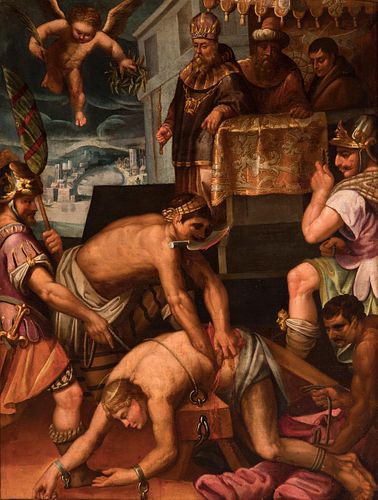Spanish mannerist school; early 17th century. "Martyrdom of St. Zoilo of Cordoba". Oil on canvas. Relined.
Lot 58
About Seller
Setdart Auction House
Carrer Aragó 346
Barcelona
Spain
Setdart Subastas was born in 2004 and is currently the first online art auction in Spain with solidity, prestige and reliability guaranteed by our more than 60,000 users. Setdart has a young, dynamic and enterprising team ready to successfully manage the purchase and sale of art works through custom...Read more
Estimate:
EUR€20,000 - EUR€25,000
$21,505.38 - $26,881.72
Absentee vs Live bid
Two ways to bid:
- Leave a max absentee bid and the platform will bid on your behalf up to your maximum bid during the live auction.
- Bid live during the auction and your bids will be submitted real-time to the auctioneer.
Bid Increments
| Price | Bid Increment |
|---|---|
| EUR€0 | EUR€10 |
| EUR€200 | EUR€25 |
| EUR€500 | EUR€50 |
| EUR€1,000 | EUR€100 |
| EUR€3,000 | EUR€200 |
| EUR€5,000 | EUR€500 |
| EUR€10,000 | EUR€1,000 |
| EUR€20,000 | EUR€2,000 |
| EUR€50,000 | EUR€5,000 |
About Auction
By Setdart Auction House
Dec 21, 2021
Set Reminder
2021-12-21 07:30:00
2021-12-21 07:30:00
America/New_York
Bidsquare
Bidsquare : Córdoba: 2,000 Years of Art
https://www.bidsquare.com/auctions/setdart-auction-house/c-rdoba-2-000-years-of-art-8049
Setdart Auction House sofia@setdart.com
Setdart Auction House sofia@setdart.com
- Lot Description
Spanish mannerist school; early 17th century. "Martyrdom of St. Zoilo of Cordoba". Oil on canvas. Relined. Presents repainting, polychrome later; original frame with faults. Measurements: 138 x 102 cm; 167 x 131 cm (frame). Anchored to the ground with some chains, and besieged by a group of characters, the protagonist of this scene, St. Zoilo, already dejected, is contemplated by a group of characters, among which stands out the angel that carries the crown of the victors. Zoilo of Cordovan origin came from a family of the Roman nobility, although he had been educated in the Christian faith. After the arrival of Diocletian to the empire began a persecution of all those who professed Christianity, led by the judge Dacian. Zoilus, who did not hide his religion, was recalled by Dacian, who reproached his behavior and told him "Our religion is authorized with antiquity; but yours was born yesterday, so helpless, that it is an affront to profess it, and so persecuted, that not to leave it is a temerity. Believe me, Zoilo, and act like an honest man: leave the error in which you are, otherwise you will be the victim of my indignation, and the chastisement of your fellows". Zoilus did not abandon his Christian faith and defended it against Dacianus, who made him choose between living and rejecting the Christian faith, or dying under torture. Choosing the Christian religion, Zoilus was condemned to suffer martyrdom, during which he pronounced these words: "Wound, tear, and rend my body, for the more you torment it, the more my crown will grow; for my Master and Lord Jesus Christ teaches his disciples in his Gospel not to fear those who can only cause bodily death. Know that for me this is the end of all evils, and the beginning of infinite happiness; but for you it will be the entrance to an eternal night of infernal darkness where in the company of demons you will be tormented forever and ever without hope of relief". Due to the technical characteristics, such as the modeling of the forms, the tonalities used, the type of composition, and even the aesthetic details used in the treatment of the canvases that make up the scene, this work can be inscribed within the mannerist school.
- Shipping Info
-
In-house shipping available. Please inquire at admin@setdart.com.
-
- Buyer's Premium



 EUR
EUR CAD
CAD AUD
AUD GBP
GBP MXN
MXN HKD
HKD CNY
CNY MYR
MYR SEK
SEK SGD
SGD CHF
CHF THB
THB

















